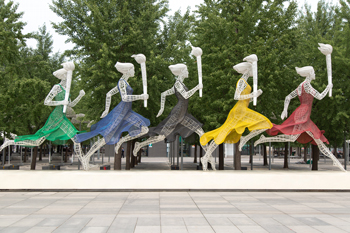
With most sports canceled or having severely shortened seasons and the Summer Olympics postponed until July 2021, you might be missing your sports fix this summer. In case you need a taste of the thrill of victory and the agony of defeat, we’ve compiled a collection of sports books for you to read this summer. Instead of a torch, light a candle, and let the reading marathon begin.
The Wave: In Pursuit of the Rogues, Freaks and Giants of the Ocean by Susan Casey
Surfing was supposed to make its debut as an Olympic sport this year in Japan. Until the medals are handed out next year, you can take a deep dive into the world of big wave surfing with Casey’s book. She provides vivid descriptions of the world’s most punishing surf breaks and the superhuman athletes who ride them. She also gives us pause in describing the larger implications of rising seas and more big waves.
The Perfect Mile: Three Athletes, One Goal, and Less Than Four Minutes to Achieve It by Neal Bascomb
During the 1950s, before technology dictated training techniques, the race was on for runners to break the 4-minute mile, a barrier believed by many to be insurmountable. Bascomb’s book follows three athletes, who after defeat at the Helsinki Olympics, were determined to achieve the unachievable. He spins a spell-binding story of determination and discipline. These men stole headlines from the Korean War, Willie Mays, and Ben Hogan. Bascomb delivers a breathtaking story highlighting the twilight years of the golden age of sport.
Tigerbelle: The Wyomia Tyus Story by Wyomia Tyus and Elizabeth Terakis
For another fascinating look at running history, look no further than this book. The story of Wyomia Tyus and the Tennessee State Tigerbelles has been likened to The Hidden Figures of women’s sports. Tyus and her teammates became an unparalleled force in track and field, breaking barriers, setting records, and challenging the racism and sexism of their era. In 1968, Tyus became the first woman to win gold medals in the 100-meter sprint in two consecutive Olympic Games.
For the Glory: Eric Liddell’s Journey from Olympic Champion to Modern Martyr by Duncan Hamilton
Born in China to Scottish missionaries, Eric Liddell ran and lived for the glory of his God. He was the greatest sprinter in the world in 1924. In the 1924 Paris Olympics, the qualifying heats for the sprint event were held on a Sunday, and he refused to run on the Sabbath, for which he was ridiculed by most of the world. He triumphed in a new event, running the 400 meters, breaking both the Olympic and world records.
In 1982, the film Chariots of Fire, which portrayed the life of Eric Liddell, won several Academy Awards including Best Picture.
Native American Son: The Life and Sporting Legend of Jim Thorpe by Kate Buford
Native American Jim Thorpe is regarded by many as the greatest athlete of the first half of the 20th century. Although he exceled in football, track and field, and baseball, Thorpe’s life was very difficult from the beginning and things never got easier. Perhaps his greatest achievement was winning gold medals in both the decathlon and pentathlon in the 1912 Olympics, a super-human feat. He was stripped of his medals the next year when it was discovered that he had violated the amateur athletic code by being paid to play minor league baseball. The loss of his medals haunted them for the rest of his life. These medals were restored to him 30 years after his death, when the code was changed.
When Thorpe died in California in 1953, his body was sent by train to his native Oklahoma reservation, but unknown to the rest of his family, his third wife had struck a bargain with the town of Mauch Chunk, Pennsylvania to bury him there. The town was looking for something to make it a tourist attraction, and in exchange for Jim Thorpe’s being buried there, the town changed its name to Jim Thorpe. You can visit the town and his grave today off Exit 87 on the Northeast extension of the Pennsylvania Turnpike.
Open by Andre Agassi
During the 80s and 90s, Agassi transformed the stodgy sport of tennis to the younger, wilder, shorts-wearing version of itself, cemented in the 1996 Atlanta Olympics when he became the first American to win gold in men’s singles since 1924. His biography explores his deep insecurities and a complicated connection with the sport to which he dedicated his life. He reveals his demons–the strained relationship with his demanding dad, his drug usage, his failed marriage to Brooke Shields. His resulting redemption makes this memoir a winner.
Little Girls in Pretty Boxes: The Making and Breaking of Elite Gymnasts and Figure Skaters by Joan Ryan
Originally published in 1995 and reissued in 2018, Ryan’s book created controversy for exposing the exploitative side of training Olympic gymnastics and figure skating hopefuls. It exposed the eating disorders, the injuries, and the physical and verbal abuses. However, despite the outrage the book generated at the time, little changed. Spring forward to 2018 when Larry Nassar, former USA Gymnastics national team doctor was sentenced to 175 years in prison for sexually abusing young women in his care. The book remains a relevant and cautionary tale.
The Boys in the Boat: Nine Americans and Their Epic Quest for Gold at the 1936 Olympics by Daniel James Brown
This is a book where the book’s characters, setting, structure, and prose come together, and a great story flows. Witness the resilience of the young rowers struggling to find their way through the hard times of the 1930s, qualifying for the 1936 Olympics in Nazi Berlin. The poetic descriptions of boatbuilding and rowing technique add much to this story. This book is a wonderful balance of history, art, and sport.
There is also a juvenile version of this book available: The Boys in the Boat: The True Story of an American Team’s Epic Journey to Win Gold at the 1936 Olympics by Daniel Brown.
The World’s Fastest Man: The Extraordinary Life of Cyclist Major Taylor, American’s First Black Sports Hero by Michael Kranish
This book is a fascinating biography of a largely forgotten Black American, a pioneer of professional cycling. Twelve years before boxer Jack Johnson and fifty years before baseball’s Jackie Robinson, Major Taylor faced racism at every turn. Although slavery was outlawed, Jim Crow was alive and well in the country. For a brief moment in time, before the introduction of the automobile, the bicycle was king. Kranish enlightens us with how these two facts of society intersected to produce Taylor, a world champion bicycle racer who traveled the world, and when faced with continuing racism in this country, moved abroad and became the toast of Paris.
Women on the Move: The Forgotten Era of Women’s Bicycle Racing by Roger Giles
The 1890s were the height of the new ‘safety’ bicycle. The hard-to-ride high-wheelers were replaced with the safety bicycle, which had a vertical pedal arrangement and locking hubs, and the general population enthusiastically embraced it. This included women, despite critics who tried to discourage them.
Professional women’s cycle racing reigned from about 1895-1902. During these years, in large cities and small towns, women’s cycling teams drew huge crowds and were highly competitive. Tillie Anderson, Lizzie Glaw, and Dottie Farnsworth became household names and were the first great American women athletes.
Bike racing in the Olympics has been an event for men since 1896, the first modern Olympics. Women entered Olympic competition in road races in 1984 and track races in 1988.
Splash!: 10,000 Years of Swimming by Howard Means
On your mark…choose your stroke and paddle through the history of man’s relationship with water from Egyptian cave paintings 10,000 years old showing men doing the doggy paddle to modern day Olympians with their aerodynamic suits and times measured in hundredths of a second. Religious beliefs, gender disparity, segregation, architecture, and fashion are also part of the history of swimming, as are milestones like the birth of the bikini and crossing the English Channel.
Why We Swim by Bonnie Tsui
Tsui looks at five different reasons swimming is important to humans, dedicating a section to each: survival, well-being, community, competition, and “flow” of the pursuit of the sublime. Far from being pedantic, however, the book is laced with fascinating stories and facts. Meet Dara Torres, the oldest Olympic swimmer at the age of 41 and marathon swimmer Kim Chambers who took up swimming after almost losing a leg to injury. A delightful study of swimming as sport, survival, basis for community, and a route to physical and mental well-being.
Fast Girls by Elsie Hooper
This book is historical fiction, based on the true stories of Betty Robinson, Louise Stokes, and Helen Stephens, three women athletes from widely different backgrounds who aspire to become members of an Olympic team. In the 1928 Olympics, Betty Robinson competed as a member of the first ever women’s delegation in track and field. She returned home as America’s Golden Girl, but was severely injured in a plane crash that threatened to end her dreams.
These three very different women eventually join together to defy society’s expectations of what a woman can do. As the world comes closer to war, these three compete on the first interracial women’s Olympic team to be the fastest woman in the world at the 1936 Olympics in Berlin.
Don’t Tell Me You’re Afraid by Giuseppe Catozzella
Catozzella’s story is a fictionalized account of the tragically brief life of Somali runner Samia Yusuf Omar. From a very young age she dreamed of becoming the fastest runner in all of Mogadishu, in spite of the civil war raging in her country.
Training alone in the dark and in a deserted stadium, with found shoes full of holes, she represented her county in the 2008 Beijing Games. For the 2012 Games in London, she had no support from her country and had to make a five-month journey to London following the route of migrants to Italy and then to her sister’s house in Finland.
— Recommended by Regina S., Collection Management Specialist

